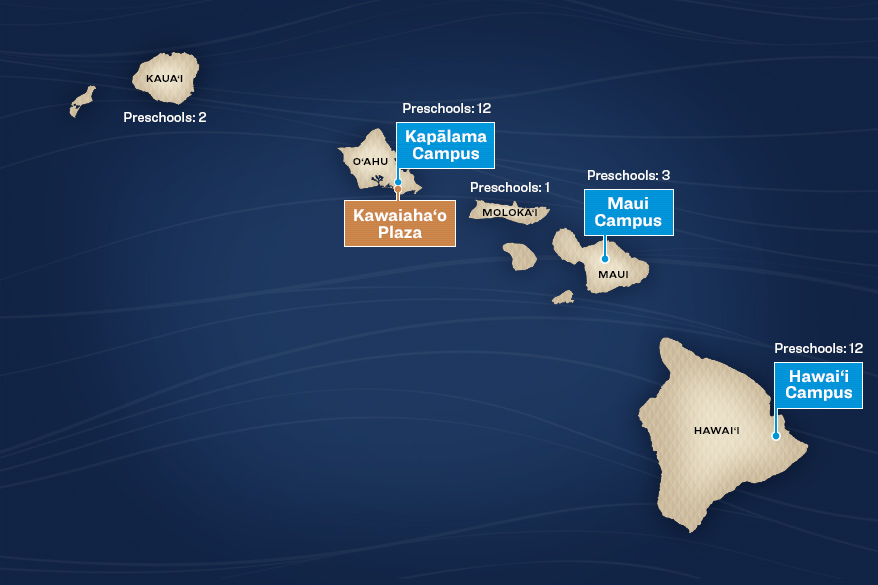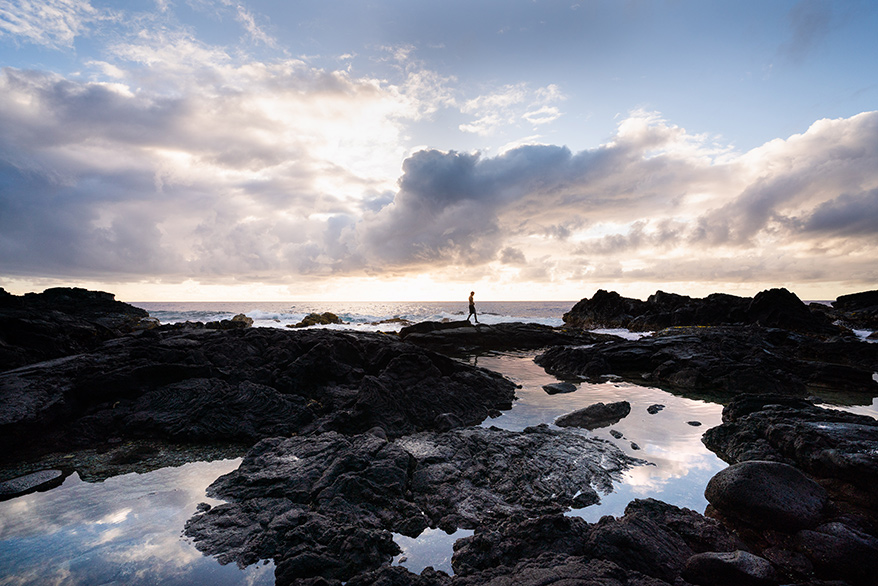Living in Hawaiʻi
Moving and returning to Hawai‘i are dreams that are shared by many. Hawai‘i offers a unique culture, demographic make-up, education system, and labor market, all which make our state a very special place to live and work.
If you’re considering a move to the islands, we want to help you understand what that commitment might look like so you can make the best decision for yourself. After all, happy and successful residents contribute largely to a vibrant and thriving Hawai‘i!
Below is a map of the Hawaiian islands showing the locations of Kamehameha Schools’ three K-12 campuses and corporate headquarters at Kawaiaha‘o Plaza, along with the number of KS preschools on each island.
Unless you’re already familiar with Hawai‘i, you might want to start by researching which island and locations are the best fit for the job market, experiences and lifestyle you are interested in. Go Hawai‘i is a great starting point as it provides detailed information about the unique attributes of each island as well as maps to help give you an idea of the distances that might be required for a commute to work.
Hunting for a hale (house)?
When it comes to finding a home, the Honolulu Board of Realtors’ HiCentral website is the source for real estate on O‘ahu. In addition to listings for rentals, homes for sale and Open Houses, it provides key market data such as median sales prices, real estate news, and important consumer information.
For neighbor island real estate information and market insights, refer to these helpful resources:
General information about each of the islands, including the number of properties available for sale and median prices, with summaries on the lifestyle, appeal and amenities found on each, can also be found here: HawaiiLife.
The Hawaii State Data Book is “the most comprehensive statistical book about Hawaii in a single compilation. Classified into 24 sections, it covers a broad range of information in areas such as population, education, environment, economics, energy, real estate, construction, business enterprises, government, tourism, and transportation.”
K-12 education in Hawai‘i
Pilina, or relationship building, is very important in the islands. If you went to high school here, new acquaintances will inevitably ask what school you went to and what year you graduated in. Also, who do you know from their family or close friends that went to the same school you did? It’s a great ice breaker but ultimately, it’s just one of many ways that islanders connect with others and help create a foundation for new friendships.
When considering a K-12 school for your keiki, it’s a matter of choosing a public or private school, knowing the pros and cons of each and the available options. Here are a couple great starting points for researching schools in Hawai‘i:
Fur babies in the ‘ohana?
If you have pets, please be aware that Hawaiʻi has strict animal quarantine laws to prevent the introduction of rabies into our islands. For information regarding the State of Hawai‘i’s quarantine program and requirements, visit: https://hdoa.hawaii.gov/ai/
Our island culture
Here in Hawai‘i, we love our food and the cuisine of our islands reflects our diverse ethnic and cultural melting pot. Food is considered a basic form of hospitality and no gathering is complete without some kind of delicious treat, buffet-worthy spread or potluck. Fresh tropical fruits and vegetables, locally raised beef, farm-fresh eggs, and “catch of the day” fish are all widely available and, while locals and tourists alike love Hawaiian food, Japanese, Chinese, Korean, Filipino, and Portuguese are among the many international influences that are represented in our island food scene.
The ALOHA spirit
Aloha is commonly understood as love or affection. It also means compassion, kindness, grace and is a greeting or salutation. Often experienced through a warm hug and kiss on the cheek when meeting acquaintances, or the friendliness of new colleagues or neighbors, the aloha spirit is more a way of living than a concept. The Hawai‘i Law of The Aloha Spirit is outlined in Hawai‘i Revised Statutes, Chapter 5, where we are encouraged to perpetuate the hospitality, goodwill and genuine aloha that is characteristic of Native Hawaiian culture and to “think and enote good feelings to others.”
A state of health and happiness
For the last 7 years, Hawai‘i has been ranked by Gallup as the happiest and healthiest state in the U.S. However, Hawai‘i only ranks #5 for the state with the highest median household income. As the old adage says, money doesn't buy happiness!
Five distinct categories of well-being were considered in the Gallup survey:
- Career: liking what you do each day and being motivated to achieve your goals
- Social: having supportive relationships and love in your life
- Financial: managing your economic life to reduce stress and increase security
- Community: liking where you live, feeling safe and having pride in your community
- Physical: having good health and enough energy to get things done daily
It's not too hard to see why Hawai‘i is the happiest and healthiest state. ‘Ohana is very important and many residents enjoy close-knit communities comprised of family, friends and neighbors. While the cost of living is considered high, unemployment is consistently much lower in Hawai‘i than the average for the contiguous 49 states. Lastly, in addition to being surrounded by the Pacific Ocean and beautiful beaches, our islands also boast fantastic rainforest, waterfall and mountain ridge hikes with unparalleled views. Due to our temperate climate, residents are able to get outdoors all year long for ocean and other outdoor activities/sports and enjoy the clean, fresh island air.
If you value time with ‘ohana and friends and the outdoor experiences that island living has to offer more than a higher household income and/or lower cost of living, then Hawai‘i might be a good fit for you.
Making the move
Moving is always a challenge but crossing the Pacific makes it a real adventure! If you’re relocating from the mainland U.S. or from outside the U.S., you will want to carefully consider the pros and cons of shipping your household items. Depending on how much you are willing to spend, you might want to sell your furniture and other bulky items or you could opt to pay for a shipping container or pod. This also applies to your car(s). Depending on the departure and arrival ports, it could cost upwards of $2,500 to ship a single vehicle to Hawai‘i from the contiguous U.S. states.
Kamehameha Schools’ Relocation Allowance
Kamehameha Schools (KS) recognizes the need to conduct broad candidate searches to find the talent and skills needed to achieve its organizational goals. Selected candidates are not necessarily required to be geographically located on the same island that their position is based on, but they do need to reside within the state of Hawai‘i. Relocation assistance may be offered on an approval basis to select candidates, to aid in their transition into a KS position.
All relocation funds received are considered taxable income. The tax treatment of any such allowance shall be in accordance with applicable federal and state laws. Please consult with your tax advisor if you have any questions on this matter or reference IRS Publication 521 – Moving Expenses.













